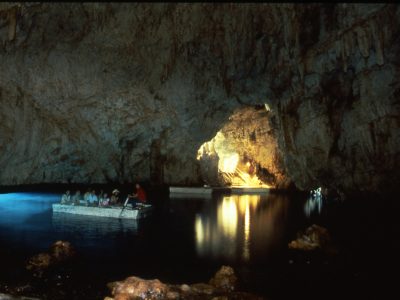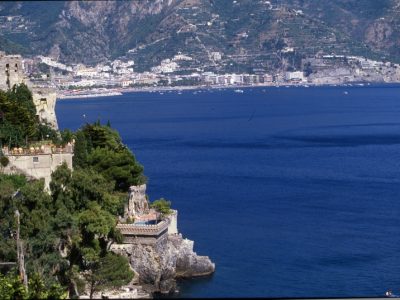Submerged world

Costiera Amalfitana with its near 50 km of coast offers the opportunity to live involving dives on seabeds which increase from seashore as far as remarkable deep.
Vegetation, made of posidonia which animates sand and muddy deposits swept by rivers and fauna, that in the past was also characterized by proliferation of corals, welcomes all those want to explore this particular aspect of the Coast introducing them in a world to be discovered among submerged or emerged grottos with geologic formations produced by water actions during the centuries.
Each grotto’s beauty is enriched by sea reflexes which have different colours according to each hour and season thanks to siphons opened towards the sky.

Amalfi
Amalfi offers the opportunity to make nice dives along the town coast having also the opportunity to rely on services organized by diving centers. Seabeds are enriched with posidonia (kind of water plants) and with fish fauna which exploits numerous natural gorges and artificial structures created to support port system. Furthermore it is possible to admire submerged structures which belong to ancient ports that by this time get confused with surrounding environment.

Atrani
Atrani with its small beach at the mouth of Dragone torrent allows interesting dives thanks to seabeds that already at a short distance from seashore, deepen quickly. Seacliff which has been built to protect the living area from sea storms, developed wildlife typical of Costiera Amalfitana and among numerous rocks it is possible to admire wonderful examples of groupers which chose to build here their lairs.

Cetara
Cetara offers the opportunity of dives along the rocky seashore and particularly interesting is the sight of the area around Punta Fuenti, where with a descent of only 10 metres towards the seabed it is possible to admire submerged structures of an ancient roman docking which had to be used by an overlooking villa. The structure with parameter in opus reticulatum is still in excellent conditions, well kept thanks to the happening of a slip towards the sea and it has not been used again after the end of life in the villa.

Conca dei Marini
Submerged world of Conca dei Marini is all collected around Smeraldo Grotto, a partially submerged cavity famous for its internal water colour and it is open to tourists thanks to rafts which go around the inner basin. Inside the grotto, where it is not possible to do dives, it is visible a submerged crib located in the deepest point of the cavity and that every year is visited on Christmas time. The external natural environment of the cavity has interesting geological and naturalistic elements, also because the area is protected against strong currents thanks to the typical conformation of the bay. In ancient times the bay of Conca was famous for red Mediterranean coral fishing, whose manufacturing occurred in loco for the production of “paternoster”, the forefathers of rosary beads. .

Furore
Seabeds at Furore fjord have a rich wildlife typical of Costiera. Between posidonia and rocks more or less emerged it is easy to meet moray eels and groupers whose biggest specimen can also reach several kilos.

Maiori
Numerous submerged cavities offer to the expert visitor of dives the opportunity to know a not famous aspect of Maiori. Some of these grottos can also be visited by boat and they show interesting sights from the geological point of view. In one of this cavity the presence of a sulphureous water sping allows numerous visitors to enjoy beneficial effects of this spring. Nice to be visited or through dive is “Del Cavallo Morto” bay with its vertical walls which guests a small beach, always very crowded in summer.

Minori
At the mouth of Reginna Minor torrent, the centre gathers in the valley around the ancient centre of the roman villa which testifies first attending periods of the site. One of the best preserved archeological witnesses of the Coast, the villa shows witnesses concerning ancient life thanks to its small thermal complex, to the precious nymphaeum and the garden which hosts shows during summer time. Standing out with other coast centres in the past for pasta production and lemon trade which left from here by ships towards Italian and foreign seaports, today it offers visitors a particular product “ndundero”, a kind of very tasty gnocco, a traditional dish in occasion of the patronal festival of Saint Trofimena.

Positano
The village, famous all around the world for clothes production, the typical “pezze” made of natural fibres and coloured textiles, represent the paradigm of several Costiera Amalfitana centres: it made the whole world fall in love with Positano when it was only a fishermen village, with few houses situated on the mountain which gets as far as the beach, and then it changed into the queen of international destinations. But it is still possible to taste old Positano atmosphere avoiding most crowded periods when perhaps also rain and stormy sea keep away those who only look for taking a picture of the most famous world view. Interesting to be seen is the roman villa, recently discovered which reminds us the beginning of this coast centre.

Praiano
Set in a bay, the village is divided in two parts by the state highway which crosses horizontally the whole Coast but on the horizon it embraces some of the most beautiful views of the world: Capri, little isles de Li Galli and the next Positano appear, at sunrise and at sunset, in the same natural way they appeared before they were involved in tourism. Crossed by “Dei Path” reachable by different link roads, in the high part, it offers the visitor a particularly interesting place of faith: S. Maria del Castro Convent, situated 364 meters above sea level, to which an ancient tradition is linked, la luminaria di S. Domenico. On the first days of August, the village is lightened with candles and torches to remember the famous dream which came before the birth of the Saint

Ravello
Ravello has also part of the village which gets straight on to the sea. The shore line, between Marmorata area in east and Castiglione in west, offers the opportunity of dives on rocky seabeds where fish fauna is composed by fish which prefer rocks. In Marmorata place, near a waterfall which carries cold water from mountains for a long route, it is possible to admire examples of pinna nobilis.

Vietri sul Mare
It has always been nearer to Salerno than to Amalfi, the centre of Vietri is well-known for pottery art, whose tradition dates back to Middle Ages. The ability to work clay to create daily use kitchenware met artistic inspiration of both local workers and foreigner painters who had reached the Coast because attracted by beauty of the places, and then remained and acted together with local people, transforming products from simple home use to art masterpieces. Nice are majolicas there is no church of the Coast which has no floor with them, and typical plate service with natural colours and with decorations which contain typical subjects of the coast.

